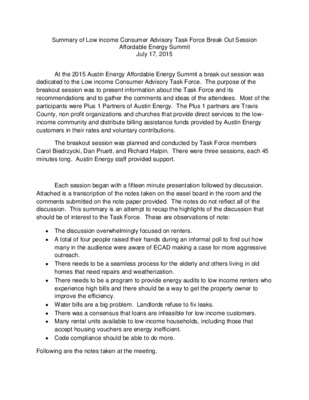Item 3c-Summary of LICATF Break Out Session from Affordable Energy Summit_Carol Biedrzycki — original pdf
Backup

Summary of Low income Consumer Advisory Task Force Break Out Session Affordable Energy Summit July 17, 2015 At the 2015 Austin Energy Affordable Energy Summit a break out session was dedicated to the Low income Consumer Advisory Task Force. The purpose of the breakout session was to present information about the Task Force and its recommendations and to gather the comments and ideas of the attendees. Most of the participants were Plus 1 Partners of Austin Energy. The Plus 1 partners are Travis County, non profit organizations and churches that provide direct services to the low-income community and distribute billing assistance funds provided by Austin Energy customers in their rates and voluntary contributions. The breakout session was planned and conducted by Task Force members Carol Biedrzycki, Dan Pruett, and Richard Halpin. There were three sessions, each 45 minutes long. Austin Energy staff provided support. Each session began with a fifteen minute presentation followed by discussion. Attached is a transcription of the notes taken on the easel board in the room and the comments submitted on the note paper provided. The notes do not reflect all of the discussion. This summary is an attempt to recap the highlights of the discussion that should be of interest to the Task Force. These are observations of note: The discussion overwhelmingly focused on renters. A total of four people raised their hands during an informal poll to find out how many in the audience were aware of ECAD making a case for more aggressive outreach. There needs to be a seamless process for the elderly and others living in old homes that need repairs and weatherization. There needs to be a program to provide energy audits to low income renters who experience high bills and there should be a way to get the property owner to improve the efficiency. Water bills are a big problem. Landlords refuse to fix leaks. There was a consensus that loans are infeasible for low income customers. Many rental units available to low income households, including those that accept housing vouchers are energy inefficient. Code compliance should be able to do more. Following are the notes taken at the meeting. Notes from Low income Consumer Advisory Task Force Break Out Session Affordable Energy Summit July 17, 2015 Comments on the Easel Board Session 1 Task Force contact is Sady.Bartlett@austinenergy.com. More information needed for lower income customers regarding programs offered by Austin Energy. Request more flexibility on payment due dates. Request training for landlords on ECAD. Tenants can request an ECAD audit from landlords. Task force should continue on with its work and identify how it can be continued and important areas of focus. Copy the county commissioners on city council meetings and recommendations. Session 2 Help Austin Energy target the high energy users (apartment owners) Make sure section 8 providers be required to have weatherization and energy efficiency and that it be monitored. Make sure home repairs and weatherization are working together. Real time of current billing usage apps do not work. Encourage Tenant’s Council to become more involved with ECAD ordinance. Integrate Austin Energy programming with social service/faith based agencies more effectively. Participants take a financial budgeting class. Session 3 More movement on ECAD ordinance in the apartment community. Set up a compliance process for residents to anonymously voice their concerns about apartment owners not complying with the ECAD ordinance. Add water audit to ECAD. Pipeline to code enforcement. Look at St. Vincent DePaul and Randolph Brooks as a model for paying off loans. Comments from Individual Notes One stop shopping to combine available services. What happened to the program that loans money to consumers for home repairs and if they live there for 15 years or more the loan doesn’t have to be repaid? Have you considered an AE online program that service providers could use to see what their clients could prequalify for (multiple programs)? Provide access to communities (undocumented, those with barriers to lease like credit, income, and criminal) who are afraid to anger their landlord by directly requesting improvements from their landlords. Education for customers is key, especially with low income customers. Education can be improved in a couple of ways. We have two resources not being used for maximum effectiveness (A) Plus 1 (P1) Partners and (B) the utility bill. A. AE provide to P1 *(Plus 1) Partners a checklist of key items to be discussed with potential P1 recipient. This doc to be signed by both P1 interviewer and client and submitted with P1 voucher before P1 funds can be poste to customer’s account. B. Improve use of utility bill for educational purposes: 1. Upper L/H corner of bill looks like “boilerplate” and is usually ignored by customers. Improve utilization of this area by: a. increase font size for easier readability b. highlight key/new items in color c. if space is inadequate, utilize back side of last page which ios usually blank. 2. Use color with graphs to focus customer attention in this area. Color daily and annual costs to focus attention to these csts, etc. Water usage daily costs are often a revelation to customers. 3. Enlarge and use color to enhance visibility and awareness ot graph scales. 4. Color code name/address of the two official payment sites. Prepared by: Carol Biedrzycki, Chair, Low Income Consumer Advisory Task Force